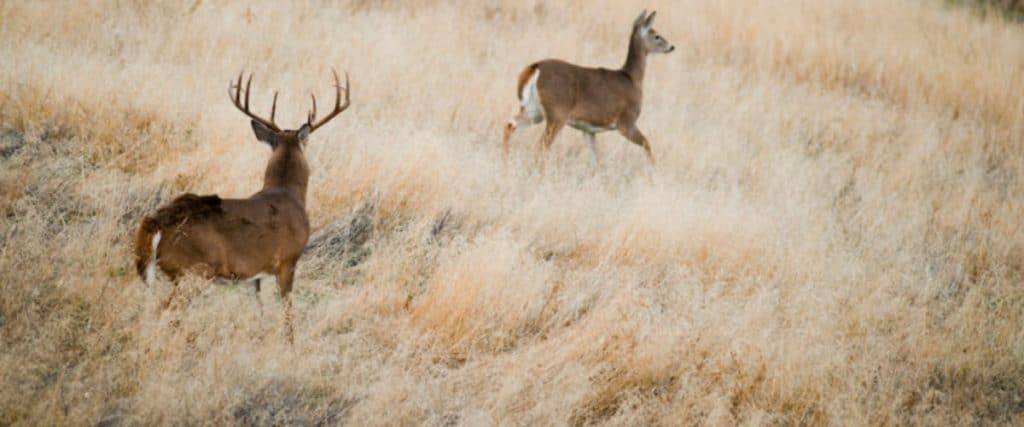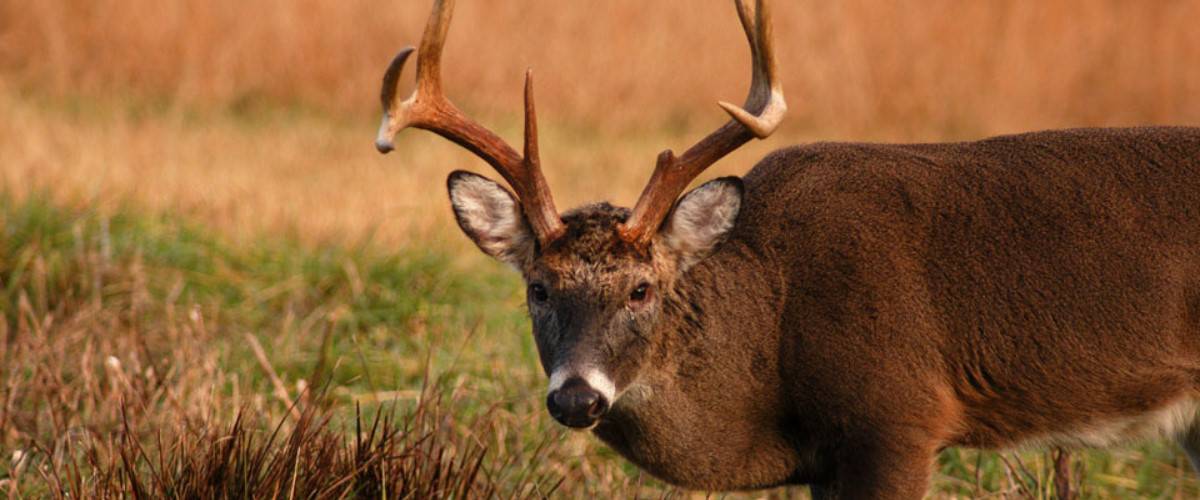As the deer rut swings into full gear, mother nature plays a trick on male deer, and seasoned hunters with rut tactics can seize the occasion to tag the biggest buck! This is the time when older and rut-crazed bucks let some of their guards down in search of a doe to mate. During peak breeding, the hormonally charged bucks make rut rubs on tree trunks near receptive does. In addition to rubs, the bucks also create half-hearted scrapes on the ground to send messages to does and nearby bucks.
As North America’s most hunted big game, the white-tailed deer remains a subject of hunting tales, especially during the rut. Hunting the rut comes with excitement and arguably the hunters’ best chance at landing a trophy buck.
Usually, a rutting area is characterized by the availability of forages to feed and cover for the paired-up buck. Bucks will try to isolate a doe within this area until mating occurs. The hunter’s goal is to locate this area. If you are looking for the best spots to hunt during the rut, this article got you covered. Ready? Let’s go!
Chasing Whitetails During the Rut and Stuff to look out for

During the rut, a lot of activities take place in the deer world and leave the hunters with valuable information on how to go about rut hunting. Familiar sights in an area occupied by bucks during the fall are buck rubs and scrapes. If you are new to deer hunting, you may think buck rubs are simply a way the bucks get rid of their velvet. Well, it doesn’t end there. Getting rid of the velvet is just one out of many purposes of buck rubs.
Essentially, a buck rub is where a buck peels the cambium layer of a tree with its antlers to communicate with other deer in the area. In between the deer’s eyes and the antler pedicles is the second most important gland in the deer’s body: The forehead gland. When making a buck rub, the deer leaves scents from its forehead glands on the tree trunk. The information on a buck’s scent deposited on the tree includes its age, dominance status, how long its been in the area, and other kinds of social exchanges the receptive does and other bucks can pick up on.
On many occasions, the size of the buck rub is indicative of the size of the deer. Placing a trail camera in this area is something that can pay off. You can deduce the movement pattern of where those bucks are coming from and the best way to set up your hunting game plan.
Best Areas to Hunt During the Rut
Here we take a look at where to hunt during the rut to secure a true trophy.
Habitat Edges
For starters, many hunters do not know that whitetails are edge animals. Sticking to habitat edges when hunting during the rut is instrumental to tagging a big game.
Locating and hunting habitat edges during the rut is pretty much straightforward. A habitat edge is a distinct line where two habitats of different plant species meet. Using aerial maps for a large-scale inspection and little in-the-field scouting will help you locate an edge. Whitetails love to travel along habitat edges as they transition from bedding areas to feeding locations.
Consequently, an effective method of cutting off a whitetail in its track is setting up on the downwind side of a habitat edge. A habitat edge is one of the best places to hunt during the rut.
Where Does Are Feeding
During the rut, one thing on a buck’s brain is the receptive does. Grunt calls, scrapes, and rubs make their intent specific. So, they frequently hang around where the does in estrous are feeding—in essence, thinking like a buck increases your chances of intercepting one. Does usually have smaller feeding ranges compared to bucks, and they happen to remain there throughout the season. With their four-chambered stomach, a deer can eat large quantities of food at a go. The primary food source of deer includes a combination of twigs, leaves, flowering plants, shoots, nuts, and berries. Find a stand in proximity to the feeding ranges and expect to hit an actual trophy soon.
Bedding Areas
Contrary to popular belief, bucks don’t always hide in some deep, dark thickets where no hunters can find them. There may be some truth in this, but it’s not always the case. A deer’s bedding area is either thick or open. The type of bedding they choose depends on the times, hunting pressure, and weather conditions.
The open bedding areas, in most cases, are the backsides of ridges. Here the buck lies with its eyes facing a clear space. The wind from over the ridge top bears any scent of danger in the area, which the buck can easily pick up on. This strategy provides both comfort and security for the buck.
On the other hand, the buck may retreat to the thick bedding areas when he feels threatened or when it’s windy, cold, or raining hard. This area could be in the multiflora rose thicket, Creek bottom, or raspberry patch.
Locating and identifying these bedding areas could make a whole lot of difference when hunting the rut.
Trails
Every hunter understands that trails are usually places where deer have traveled. You can tell how long ago there was a deer in a location by simply examining the trails. And, of course, you can also deduce the number of deer traveling on a trail. You’d want to pay attention to high traffic lanes between bedding and feeding locations to increase your chances of intercepting a mature buck at any time. Usually, there is a lot of deer movement during the rut. Bucks will patrol trails in search of hot does in estrus as well as rivals. As rutting approaches peak levels, the deer start limiting their ranges, then contain themselves in specific locations to mate. You can set up a stand close to heavily used trails leading in and out of the bedding area and be prepared to sight a buck while you wait.
Food Sources
Because it’s the rut season, the bucks have eyes on the does. Hunters will be doing themselves a lot of good if they adjust to deer’s behavior during these times if they want to score a big kill. Usually, bucks don’t seek food sources during the rut, but they does do. The logic is simple. The pregnancy status of adults will demand that they consume more nutritious food.
Consequently, they’ll navigate from areas bearing soft mast and other field crops to those with acorns of white oaks, beech, and pecans. While nuts from red-oaks form a crucial part of deer’s diet, they are not playable to the deer during the rut. Does coming to the known food source during the rut will draw in mature bucks in the area. Be sure to position close to a food source, preferably an oak tree, and let the does do their thing.
Just Outside the Cities
It shouldn’t come as a surprise that some of the biggest bucks live just outside the cities. Over the years, savvy hunters have managed to produce some super bucks within city limits. Sometimes, all that is required is thinking outside the box.
The typical food plots like the big ag fields are not readily available within the burbs, but some bucks have found landscape plants a perfect alternative. The suburban deer spend most of their lives moving from one patch of placid cover to the other. Hence, the hunter’s job is to be in a position to intercept their movement. Be sure to use the right hunting weapon as some states prefer bows instead of firearms and long range rifle scopes within city limits.
Final words
Knowing how to hunt the rut and where to look is crucial during the rut. Many hunters have their unique style of tracking bucks in the rut season. However, the places mentioned above are some of the best when looking to tag a trophy buck. During the rut season, bucks are simply single-minded: quarantining a doe until mating occurs. Hunters who understand this do well to study the does movement pattern because that’s where the big bucks are. Because mating demands chasing, travel corridors and funnels become excessive traffic locations during the rut. Getting to mate with does don’t come easy. So the buck will come back time and time again to their rubs and scrapes until they fulfill their purpose. In essence, staging a stand at a location with many buck activities increases your odds of tagging one. The rut season is packed with excitement and rewards, especially when you have the proper hunting gear. In addition to your weapons, be sure to read vortex scope reviews to pick the best glass during the rut season.
Mike Fellon is an experienced firearms enthusiast and optics expert. He delivers unbiased and detailed rifle scope reviews. Born and raised in Dallas, Texas. He inherited his hunting passions after his father John – he was fascinated by his stories, hearing how much attention, focus, dedication and patience he invested in shooting every animal. When he was old enough, his father first allowed him to shoot some cans and bottles with his shotgun, and then took him hunting – it was love at first sight. Mike has never stopped shooting ever since.

